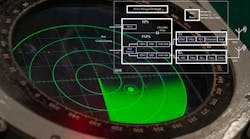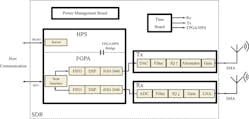This article is part of the TechXchange: Software-Defined Radio.
Members can download this article in PDF format.
What you’ll learn:
- How software-defined radio fits into various defense-related roles.
- The importance of SDR to electronic-warfare applications.
- The basics of SDR architecture.
The military and defense industry relies heavily on advanced radio technology to carry out its operations effectively and securely. From communication systems to radar equipment, understanding and interacting with radio frequencies plays a crucial role in maintaining national security.
In recent years, software-defined radios (SDRs) have emerged as the next generation of wireless systems, revolutionizing the way military and defense organizations operate. With their versatility and adaptability, SDRs are having a significant impact on key markets such as radar, spectrum monitoring and recording, and electronic warfare.
This article will delve into the world of RF for military and defense, exploring the capabilities and advances that SDRs bring to fundamental applications of this industry, including radar transceivers, spectrum monitoring, and electronic warfare. It also discusses the basic concepts and main features of state-of-the-art SDRs.
At the end of the article, the reader should be able to understand what are SDRs and how they work, how these transceivers fit into each application, and the main RF parameters that must be considered when selecting or designing SDRs for the military industry.
How RF Devices Fit into Defense Roles
Since the early days of analog radio, RF transceivers have been an integral part of warfare and defense operations, especially considering the tremendous strategic advantage introduced by wireless communications in tactical missions.
With the advancement of radio to modern software-based systems, SDRs became a crucial device for uses beyond telecommunication systems and into highly specialized and complex RF applications. Such apps require not only exchange of data through the air, but also detailed analysis of the electromagnetic signals, high levels of reconfigurability/adaptability, and high-throughput data interfaces for integration with host computers to allow for remote control and monitoring.
In military radar systems, RF devices represent the heart of the operation. A radar system transmits a custom waveform that’s broadcast to all directions of the region of interest. It then receives/decodes the reflected signals to obtain position and velocity information about a certain target. Therefore, it must implement at least one transmitter chain, one receiver chain, a duplex switch, and a digital back end for waveform generation and signal processing.
At the transmitter side, several parameters can limit performance, including the resolution of digital-to-analog conversion of the waveform, the specific frequencies that are broadcast through the transmitter, and the antenna’s output power distribution. At the receiver side, the radio chain must have excellent phase stability and coherency to accurately receive and mix the signal. In addition, it must provide a high dynamic range and low noise figure to dynamically attenuate/amplify the received reflection to eliminate clutter/jams and reduce noise.
Furthermore, beamsteering/beamforming techniques have been widely implemented to reduce the effects of jamming and interference, diminishing the received power at certain points. In this case, multiple-input, multiple-output (MIMO) systems with powerful parallel computing and high phase stability are crucial to leverage performance and precision.
In terms of software, the DSP capabilities of the digital back end must provide very-low-latency computation and a high-throughput data interface with the host network to prevent information lost while tracking fast targets. For anti-jamming techniques, such as frequency hopping, the digital back end must be able to quickly detect power thresholds and adapt the waveform and modulation scheme accordingly.
Spectrum Monitoring
Another application of RF devices that’s crucial to modern warfare is spectrum monitoring, especially considering that most tactical endeavors rely heavily on wireless communication and electromagnetic attacks. Spectrum monitoring is the process of analyzing and monitoring the usage of the electromagnetic spectrum for the purpose of detecting RF interference, monitoring adversarial communication and radio activity, and obtaining situation awareness in the battlefield.
RF devices must provide several key features to ensure spectrum coverage and high-performance detection. First, the receiver of the radio front end (RFE) has to provide a wide tuning range and high instantaneous bandwidth, so that the same device can be used to cover a wide range of signals.
Moreover, MIMO devices with independent channels can significantly expand the spectrum coverage by assigning a bandwidth portion to each channel, which increases the effective spectrum coverage and maximizes the probability of detecting signals. Spurious-free dynamic range (SFDR) of the radio device significantly impacts the accuracy of measurements; thus, selecting SDRs with high SFDR will certainly improve performance.
On the software side, a powerful digital back end is fundamental in handling the huge amounts of data involved, especially if implementing multiple channels. In this case, FPGAs with on-board DSP capabilities are the way to go, as they provide very-low-latency computation and can handle parallel computing without major hardware specialization. Furthermore, the FPGA must offer high-throughput interfaces with host computers and storage solutions to ensure the integrity of the measured data.
Electronic Warfare
Because RF devices are so intimately connected to military applications, the electromagnetic environment has become a battlefield of its own, with its rules and players. Electronic warfare (EW) was created to fight these battles, specifying devices, techniques, and strategies to gain the upper hand in the RF realm.
EW devices play a crucial role in ensuring the success of military operations, by protecting against and exploiting enemy communications and radar systems. They typically consist of three elements: attack, protection, and support. The attack element uses radios to interfere with and disrupt enemy communications and devices, creating confusion and reducing the effectiveness of their operations. Such devices typically implement high-power transmitters and advanced jamming techniques to interfere with enemy signals.
For protection, EW systems use RF devices to detect and protect against incoming enemy electronic attacks, typically involving highly sensitive receivers and advanced signal-processing techniques to detect and counter enemy signals in time to react. The support element of EW systems employs RF devices to gather information and provide situational awareness to military operations—spectrum-monitoring devices and radars fit into this category.
In any case, EW RF devices must not only offer lots of output power and receiver sensitivity, but also provide a high level of reconfigurability to adapt their RF performance according to the scenario and flexible size, weight, and power (SWaP) characteristics.
What’s an SDR?
An SDR is basically an RF transceiver with two main parts: a RFE and a digital back end. The RFE contains all of the receive (Rx) and transmit (Tx) RF chains, including amplification, filtering, and antenna coupling interfaces. The RFE must be able to receive signals over a wide frequency range (typically 0 to 18 GHz, upgradable to 40 GHz), while also providing a high instantaneous bandwidth. Some of the highest-bandwidth SDRs offer up to 3 GHz/channel.
Each channel of the RFE is connected to the digital back end via high-performance analog-to-digital and digital-to analog converters (ADCs/DACs) that are independent for each Rx/Tx chain, enabling parallel operation that makes MIMO SDRs a “several-in-one” type of equipment.
Digital back end
The digital back end of an SDR contains an FPGA with onboard DSP capabilities for tasks such as modulation, demodulation, upconverting, downconverting, and so on. It’s also highly configurable and upgradable, allowing for the latest radio protocols and DSP algorithms to be incorporated into the system. Thus, SDRs are ideal for military and defense applications in which adaptability, performance, and reliability are critical.
Furthermore, the digital back end offers embedded data packaging and high-speed optical interfaces for high data-throughput communication with the host and storage solutions, making them ideal for spectrum-monitoring systems. The figure shows a high-level diagram of the SDR, specifying the main functions of each board, including the RFE, the digital backend, the power distribution, and the clock generation.
Radio front end
The RFE of an SDR is a critical component that plays a vital role in the device’s performance. The Rx chain includes multi-stage chains (such as low/baseband and high band), LNAs and power amplifiers, attenuators for dynamic adjustment of signals, IQ downconverters, anti-aliasing filters, and ADCs that connect to the FPGA via JESD204B.
At the Tx side, the signal path also goes through multi-stage chains, beginning at the FPGA, passing through the DAC, anti-imaging filters, frequency synths and local oscillators, IQ upconverters, and RF gain blocks. High-performance SDRs typically include completely independent Tx and Rx chains for optimal signal processing and parallel configuration.
Timing and power boards
To support these functions, SDRs also rely on other boards for timing and power (see figure, again). Timing boards provide clocks for ADCs, DACs, local oscillators, mixers, and the FPGA, while power boards ensure stable power supply to all other components. These elements are essential to achieving high performance and reliable operation in these transceivers.
FPGA
The digital back end of a high-end SDR includes an FPGA equipped with onboard DSP capabilities that can be optimized for a range of functions including modulation, demodulation, and up/downconverting. These capabilities are used to perform tasks like CORDIC mixing, data packetization, and FIFO buffers, as well as any application-specific requirements such as channelization, security schemes, and artificial-intelligence/machine-learning algorithms.
The FPGA also allows for ultra-low-latency communication, and is responsible for communicating with the host system, network, or storage solution. This communication, done through Ethernet (SFP/qSFP+) ports and MGMT ports, enables the host system to remotely configure and control the SDR. Through these interfaces, the host also can send, receive, capture, and monitor raw IQ data, using proprietary, open-source (GNU-Radio), and custom software. With achievable data rates of 10 to 400 Gb/s, the FPGA plays a crucial role in optimizing the SDR’s performance.
In the current RF landscape, defense systems require a variety of RF devices and systems to meet their needs for spectrum monitoring, EW systems, and radars. SDRs provide a flexible solution for these needs by enabling the RFE and digital back end to be adapted and upgraded on-the-fly and remotely.
The radio front end of an SDR contains one or more receive and transmit channels, capable of working with signals in a wide tuning range. The digital back end implements an FPGA with DSP capabilities for modulation, demodulation, up/downconverting, and more.
In modular SDRs, all components can be customized to comply with a variety of SWaP requirements, from powerful ground station racks to onboard radars for light aircraft. The FPGA also communicates with the host system and the Ethernet ports to transport and capture data, enabling storage solutions and fast, reliable communication with the operator. The combination of flexibility, modularity, and RF performance makes SDRs the ideal choice for any military and defense situation.
Conclusion
In this article, we’ve explored the world of RF military and what specifications are key to solving most of the challenges in crucial applications, including EW systems, radars, and spectrum monitoring. SDRs have revolutionized the world of radio, as they allow for software-based adaptability across a wide range of frequencies and waveforms.
SDRs consist of two parts—a radio front end and a digital back end, with the RFE handling the reception and transmission of signals, and the digital back end performing DSP functions such as modulation, demodulation, and data packetization. The use of FPGAs with onboard DSP capabilities has further advanced SDRs, providing ultra-low-latency communication and the ability to optimize the radio for different applications.
The versatility of SDRs makes them a crucial component in meeting the ever-changing needs of the RF landscape in defense. These devices have proven to be a game-changer in the field, and their importance in meeting the challenges posed by the rapidly evolving RF landscape can’t be overstated.
Read more articles in the TechXchange: Software-Defined Radio.

